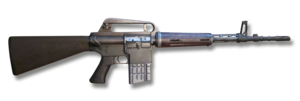
Back AR-10 Byelorussian AR-10 Breton ArmaLite AR-10 Czech AR-10 Danish Armalite AR-10 German AR-10 Spanish AR-10 French AR10 HE AR-10 ID AR-10 Italian
| ArmaLite AR-10 | |
|---|---|
 An ArmaLite AR-10 (Portuguese model) | |
| Type | Battle rifle |
| Place of origin | United States |
| Service history | |
| In service | 1960–1976 (Portugal) 1958–1985 (Sudan) |
| Used by | See AR-10 purchasers by country |
| Wars | Portuguese Colonial War Sudanese Civil War Operation Seroja Militias-Comando Vermelho conflict |
| Production history | |
| Designer | Eugene Stoner |
| Manufacturer | ArmaLite Artillerie-Inrichtingen (AI) Colt's Manufacturing Company |
| Produced | 1956–present |
| No. built | 9,900 |
| Specifications | |
| Mass | 3.29–4.05 kg (7.25–8.9 lb) w/o magazine |
| Length | 1,050 mm (41.3 in) |
| Barrel length | 528 mm (20.8 in) |
| Cartridge | 7.62×51mm NATO .308 Winchester 6.5mm Creedmoor |
| Action | Gas-operated, rotating bolt (Direct expansion of gas on surfaces of Bolt Carrier) |
| Rate of fire | 700 rounds/min (fully automatic), variable (semi-automatic) |
| Muzzle velocity | 820 m/s (2,690 ft/s) |
| Effective firing range | 600 m (660 yd) (700 m (770 yd) with A.I. 3.6× telescopic sight) |
| Feed system | 20-round detachable box magazine |
| Sights | Adjustable aperture rear sight, fixed post front sight |
The ArmaLite AR-10 is a 7.62×51mm NATO battle rifle designed by Eugene Stoner in the late 1950s and manufactured by ArmaLite (then a division of the Fairchild Aircraft Corporation). When first introduced in 1956, the AR-10 used an innovative combination of a straight-line barrel/stock design with phenolic composite, a new patent-filed gas-operated bolt and carrier system and forged alloy parts resulting in a small arm significantly easier to control in automatic fire and over 1 lb (0.45 kg) lighter than other infantry rifles of the day.[1] Over its production life, the original AR-10 was built in relatively small numbers, with fewer than 10,000 rifles assembled. However, the ArmaLite AR-10 would become the progenitor for a wide range of firearms.
In 1957, the basic AR-10 design was rescaled and substantially modified by ArmaLite to accommodate the .223 Remington cartridge, and given the designation ArmaLite AR-15.[2]
In 1959, ArmaLite sold its rights to the AR-10 and AR-15 to Colt's Manufacturing Company due to financial difficulties, and limitations in terms of manpower and production capacity.[3] After modifications (most notably, the charging handle was re-located from under the carrying handle like AR-10 to the rear of the receiver), the new redesigned rifle (the AR-15) was subsequently adopted by the U.S. military as the M16 rifle.[4][5][6] Colt continued to use the AR-15 trademark for its line of semi-automatic-only rifles, which it marketed to civilian and law-enforcement customers as the Colt AR-15.
- ^ Pikula, Major Sam (1998). The ArmaLite AR-10 Rifle: The Saga of the First Modern Combat Rifle. Regnum Fund Press. pp. 27–29. ISBN 9986-494-38-9.
- ^ Cite error: The named reference
Pikula88-90was invoked but never defined (see the help page). - ^ "ArmaLite History" (PDF). Archived from the original (PDF) on 1 October 2008.
- ^ Ezell, Edward Clinton (1983). Small Arms of the World. New York: Stackpole Books. pp. 46–47. ISBN 978-0-88029-601-4.
- ^ Kokalis, Peter G. "Retro AR-15" (PDF). nodakspud.com. Archived from the original (PDF) on June 14, 2022.
- ^ Kern, Danford Allan (15 December 2006). "The Influence of Organizational Culture on the Acquisition of the M16 Rifle" (PDF). m-14parts.com. A thesis presented to the Faculty of the US Army Command and General Staff College in partial fulfillment of the requirements for the degree MASTER OF MILITARY ART AND SCIENCE, Military History. Fort Leavenworth, Kansas. Archived from the original (PDF) on April 14, 2021.
© MMXXIII Rich X Search. We shall prevail. All rights reserved. Rich X Search